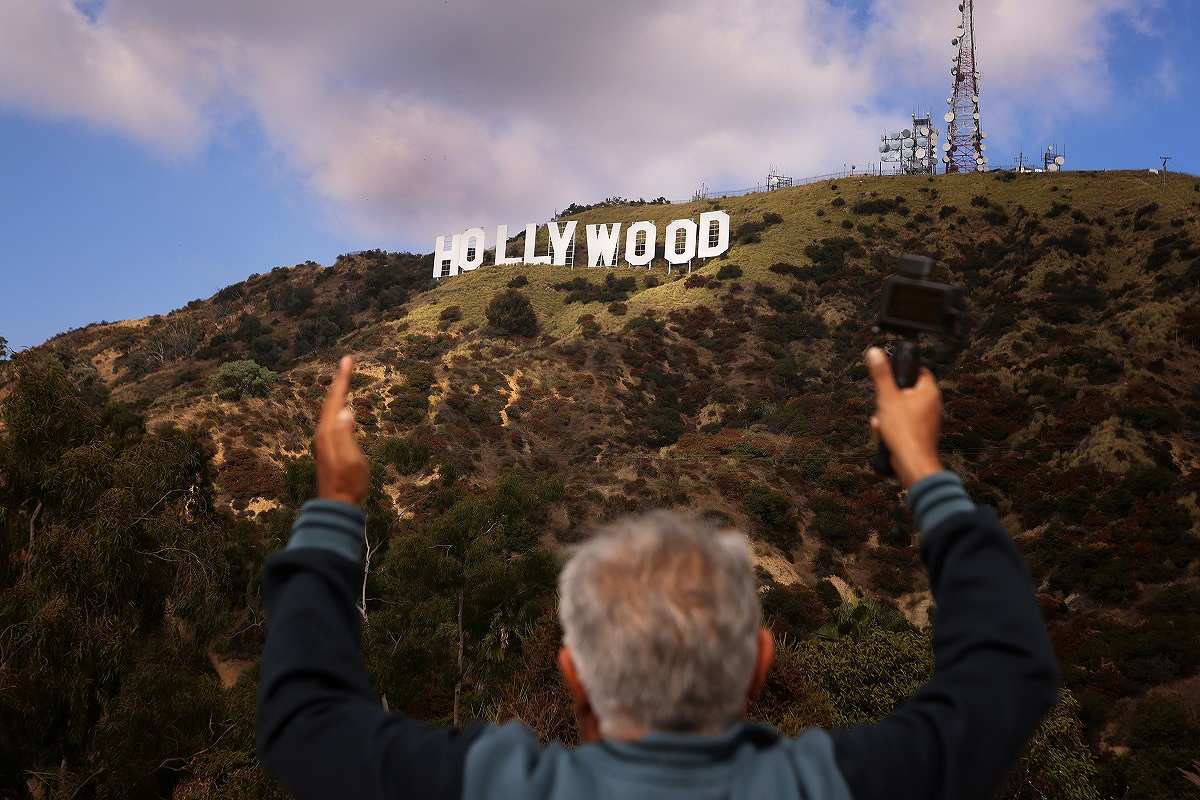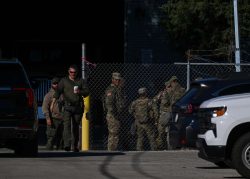
There is deep disagreement over how Los Angeles should recognize the sign’s 100th year, with the idea of illuminating it the subject of fierce debate.
13:32 JST, November 4, 2023
LOS ANGELES – This city’s most famous landmark, a glorified billboard for an exclusionary housing development, was never supposed to last for 100 years.
And yet, its 45-foot stark white letters have loomed over Los Angeles for about that long, since before movies were talkies, their century-long sentry one of the few constants in a place roiling with change.
The Hollywood sign marks its centennial this year – the idea of the Hollywood sign, that is, as the sign itself, like so much in the City of Angels, has been refurbished, remade and rewritten. Still, it remains the most potent symbol of America’s dream factory, a beacon for all who come to Los Angeles seeking fame and fortune. In a place bursting with stars, the sign is the city’s most photographed subject, its image distilling all the magic of moviemaking into a single vista.
But Los Angeles, which knows how to throw a party, is in no mood to celebrate the historic milestone. These days, this company town is in sour spirits, especially when it comes to anything even remotely associated with “the industry.” Hollywood’s writers and actors have spent months on strike, highlighting the business’s unfair labor practices and the staggering sums raked in by studio bosses. The end of the writers strike in September did little to dissipate the anger.
At the same time, city leaders have concentrated civic energy on combating the homelessness crisis, rendering gauche the idea of devoting resources to the feting of an inanimate object. Plus, there is deep disagreement over how exactly Los Angeles should recognize the sign’s big year, with the most ambitious idea – illuminating it like the old days – already the subject of fierce debate.
So, for now, the sign and its boosters have been left with a minimal honor: a morning ceremony at Los Angeles City Hall on Tuesday, where council members declared it to be Hollywood Sign Day (never mind the fact that the day will always be better known by another name: Halloween).
But if the festivities are muted and the vibes are off, it is just the latest example of the Hollywood sign’s story mirroring that of the city it sits above. In their 100 years together, Hollywood the sign and Hollywood the place have shared a saga that is defined by, as the landmark’s caretaker put it, “soaring ambition, crumbling decadence and constant reinvention.”
“The Hollywood sign is important to the entire fabric of Los Angeles,” said Jeff Zarrinnam, the chairman of the Hollywood Sign Trust, which maintains the sign. “It is the symbol of Los Angeles, it is the symbol of California, it is the symbol of America. It is our Statue of Liberty.”
– – –
From sign to symbol
Los Angeles in the years before the sign’s birth bore little resemblance to today’s sprawling megalopolis. But 1923 was a boom year. It was a time of feverish construction in the city, and one of its splashiest new housing developments was known as “Hollywoodland.”
This premiere needed a marquee. And it needed to be big.
The sign’s true origin is lost to history, but one popular tale ties it to L.A.’s then (and still) burgeoning car culture. Hollywoodland funder and newspaper publisher Harry Chandler knew the value of good marketing, and he allegedly ordered up a sign so large it could be seen while driving down Wilshire Boulevard, like a giant headline atop a story yet to be written.
Chandler got his wish. Using sheet metal and telephone poles hauled by mules onto what is now known as Mount Lee in L.A.’s Griffith Park, laborers built the sign in two months. At 13 towering letters long, the “Hollywoodland” sign was believed to be the largest in the world. And nearly 4,000 blinking bulbs later, it was lit for the first time Dec. 8, 1923.
Nobody could miss the sign’s strobe, but the housing tracts it advertised were not open to everyone.
At the time, a promotional campaign billed the city as “the white spot” of American prosperity, and a newspaper ad depicted Hollywoodland as a hilly refuge from the dark and dingy neighborhoods below, said Leo Braudy, a cultural historian and author of “The Hollywood Sign.” According to early residents, deeds in the development included racially restrictive covenants that specified “Caucasians only.”
Still, the lots sold, and houses went up.
“It was an effective billboard,” Braudy said. “But it was only meant to last a couple years. It was made out of simple material and had a kind of transience to it.”
Only later did it take on global significance.
“Like a snowball rolling down the hill,” he said, “gathering meaning as the years go by.”
First, the sign would fall into disrepair – several times. Wind and rain left the letters battered and tattered. An “O” toppled over, then the “H,” and in 1947 the city threatened to tear the whole thing down.
The warning spurred the sign’s first real restoration: The Hollywood Chamber of Commerce spruced it up and, crucially, removed the last four letters.
But by the 1970s, the sign and its namesake were again in bad shape. Changing technology posed new threats to film dominance, and most major studios had moved their lots elsewhere. The sign was rusted and rotten, giving way to termites and time.
The price tag for a complete replacement was $250,000 – more than $1.1 million in today’s dollars – and the funds came from an unlikely group. Led by recent Los Angeles transplants Hugh Hefner of Playboy fame and rock star Alice Cooper, nine donors sponsored the new letters. Not one donor was a Hollywood studio.
In August of 1978, the original sign was torn down, and the hillside was bare for three months. The successor was built for permanence, undergirded with 240 tons of cement and steel. Just in time for a new golden age of Hollywood blockbusters, the sign emerged as an international icon.
“Hollywood always reinvents itself,” said Zarrinnam, a who was born and raised in the sign’s shadow.
The next time the sign needed saving, in 2010, it had an army of defenders. Big-dollar donors teamed up with Hollywood A-listers and thousands of online supporters to raise enough money to protect the land near the sign from development. But when the campaign found itself nearly $1 million short, it was Hefner who stepped in again, with the cash and some stern words for his adopted hometown.
“This town,” he said then, “never had a good sense of its own history.”
– – –
Birthday without a party
The sign’s backers had grand plans to celebrate its once-unexpected centennial: A gala, a film festival, a miniature model to be carted around the city. At the very least, they hoped to illuminate the sign once more.
But most of those ideas have been tabled or delayed. The lighting issue in particular is “a political hot potato,” Zarrinnam said. Los Angeles Mayor Eric Garcetti, on his final day in office, issued an executive directive that allowed the sign to be lit up to six times a year.
After backlash from influential Hollywoodland residents, whose homes are now among the most coveted in L.A.’s exorbitant real estate market, Garcetti’s replacement, Karen Bass, quickly rescinded the directive. Her office cited concerns about the order’s legality; it did not respond to questions about the mayor’s stance on sign illumination.
Promoting the landmark has always been controversial in the community immediately surrounding it, where heavy traffic drawn by the sign regularly clogs narrow streets and adventurous tourists traipse through the yards of private Tudor and Spanish colonial homes.
“We’ve sort of been invaded,” said Christine O’Brien, the president of the Hollywoodland Homeowners Association and a resident since 1980. And every time the sign is lit, she said, it gets worse. “It attracts every crazy person in town. It becomes like a party, like a free-for-all. Every time it’s illuminated, we have issues.”
O’Brien has long criticized the city, the sign trust and the Hollywood Chamber of Commerce, which owns the sign’s licensing rights, saying the public-private partnership has repeatedly ignored residents’ complaints and environmental concerns. She said she would favor building a visitor center away from surrounding neighborhoods to redirect foot and car traffic.
(The trust, for its part, recently announced plans to raise money for a visitor center, though it has yet to secure a site.)
But mostly, O’Brien said, she just doesn’t get the hype.
“It is just silly,” she said of the sign. “It’s a facade. Just like almost all of Hollywood. It’s fictionalized.”
A couple of miles south, outside of Paramount Pictures, the last major studio with a lot in Hollywood, actors on strike for the 109th day had their own reasons for not celebrating the sign. Many said they weren’t aware it was the centennial. They said the sign is an important symbol, but the issues they’re picketing over have real-world impact.
“You know, it has a long history, but right now, we’re making history,” said Frances Fisher, a member of the SAG-AFTRA negotiating committee whose credits include “Titanic” and “The Lincoln Lawyer.”
Yet the sign reminds Romel De Silva, an actor who grew up in the nearby San Gabriel Valley, that he’s “part of this long, labored history,” and it pushes him to advocate for future generations.
“Our legacy is in ruins at the moment,” he said. “We want to fight as hard as we can to maintain that legacy.”
At Tuesday’s ceremony in Los Angeles City Hall, Council member Nithya Raman, who represents the district that includes Hollywoodland, introduced the official proclamation to a smattering of applause.
“The sign has been a defining feature of Los Angeles since before any of us here today were born, and to imagine our city without it is truly impossible,” said Raman, whose husband, Vali Chandrasekaran, is a TV writer who has worked on “Modern Family” and “30 Rock.”
The proclamation presentation was wedged between agenda items. On a table in the middle of the council chambers sat a pink-frosted cake with the number 100 atop it. A glitzy gala this was not.
But Paul Krekorian, the city council’s president, had his own idea for a tribute, nodding at the specter of one of the industry’s longest-ever work stoppages: “Let’s hope that we’re all celebrating Hollywood Sign Day today by urging all of our friends in labor and management to continue to negotiate and get this deal done,” he said.
After such a tumultuous year, what could be a more Hollywood ending?
"News Services" POPULAR ARTICLE
-

American Playwright Jeremy O. Harris Arrested in Japan on Alleged Drug Smuggling
-

Japan’s Nikkei Stock Average as JGB Yields, Yen Rise on Rate-Hike Bets
-

Japan’s Nikkei Stock Average Licks Wounds after Selloff Sparked by BOJ Hike Bets (UPDATE 1)
-

Japan’s Nikkei Stock Average Buoyed by Stable Yen; SoftBank’s Slide Caps Gains (UPDATE 1)
-

Japanese Bond Yields Zoom, Stocks Slide as Rate Hike Looms
JN ACCESS RANKING
-

Tokyo Economic Security Forum to Hold Inaugural Meeting Amid Tense Global Environment
-

Keidanren Chairman Yoshinobu Tsutsui Visits Kashiwazaki-Kariwa Nuclear Power Plant; Inspects New Emergency Safety System
-

Imports of Rare Earths from China Facing Delays, May Be Caused by Deterioration of Japan-China Relations
-

University of Tokyo Professor Discusses Japanese Economic Security in Interview Ahead of Forum
-

Japan Pulls out of Vietnam Nuclear Project, Complicating Hanoi’s Power Plans
























